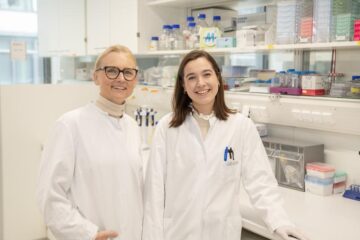Rutgers scientists perform ’materials magic’ to simplify crystal-making for electronics

Materials scientists at Rutgers, The State University of New Jersey, have devised a novel and easy technique to make thin, crystal-like materials for electronic devices. The technique could supplement today’s tedious and exacting method of growing crystals with an additional benefit of producing materials in sizes and shapes not now possible.
In a recent issue of the American Chemical Society journal Langmuir, Rutgers scientists and collaborators from Ceramare Corporation and the University of California, Berkeley, report on a method where they coax thousands of microscopic grains of individual crystals to assemble into tightly packed layers. The resulting orderly array of particles mimics the performance of traditionally fabricated crystalline wafers, without the time and expense of growing crystals in a molten mixture or solution, then slicing them into thin layers.
“The materials we’ve created in our lab bridge the gap between single-crystal materials, with their precisely ordered atomic structures, and ceramics, which have randomly oriented structures,” said Richard Riman, professor of ceramic and materials engineering. “These so-called ’single-crystal-like’ materials possess properties approaching those of true single crystal materials, but since we make them with techniques drawn from ceramic fabrication, there is potential to synthesize them economically and in large size and quantity.”
Riman and his colleagues conducted their research with lead zirconate titanate, or PZT, which is used in motion sensors, electrical capacitors and even for vibration damping in high-performance skis and tennis racquets. PZT has proven almost impossible to fabricate as a single crystal, which limits practical applications to the material’s polycrystalline form; that is, a solid mixture of small crystalline particles. Even the most sophisticated lab techniques have produced crystals no larger than a quarter-inch across. A number of new applications in sensing, imaging and energy storage appear possible if the material can be fabricated in a variety of sizes and shapes with the highly ordered atomic structure of crystals.
The Rutgers-led team created PZT particles using chemical processes, forming cubes of uniform shape and size, between two and three microns on a side (almost 50 times smaller than a grain of table salt). The team then made a slurry of PZT cubes in an alcohol and mineral oil mixture and placed droplets of the slurry on a water surface. Various forces, including the water’s surface tension, caused the cubes to “self-assemble” into a densely packed single layer. The scientists then picked up the array of cubes onto a glass tube or microscope slide, resulting in a thin layer of crystal-like PZT.
Using a sophisticated technique called atomic force microscopy, the scientists measured piezoelectric properties, or the ability to generate electricity by causing vibrations, in the PZT array. They found it had properties comparable to that of a true single-crystal structure. While additional work will be needed to make the fabrication process practical for large-scale production, the research suggests it will be possible to make materials with unique shapes and properties.
Media Contact
More Information:
http://www.rutgers.eduAll latest news from the category: Materials Sciences
Materials management deals with the research, development, manufacturing and processing of raw and industrial materials. Key aspects here are biological and medical issues, which play an increasingly important role in this field.
innovations-report offers in-depth articles related to the development and application of materials and the structure and properties of new materials.
Newest articles

Possible alternative to antibiotics produced by bacteria
Antibacterial substance from staphylococci discovered with new mechanism of action against natural competitors. Many bacteria produce substances to gain an advantage over competitors in their highly competitive natural environment. Researchers…

Researchers have found brown fat’s “off-switch
Researchers from the University of Southern Denmark, the Novo Nordisk Center for Adipocyte Signaling (SDU), the University of Bonn and the University Hospital Bonn (UKB) have found a protein that…

Combining robotics and ChatGPT
TUM professor uses ChatGPT for choreographies with flying robots. Prof. Angela Schoellig has proved that large language models can be used safely in robotics. ChatGPT develops choreographies for up to…





















